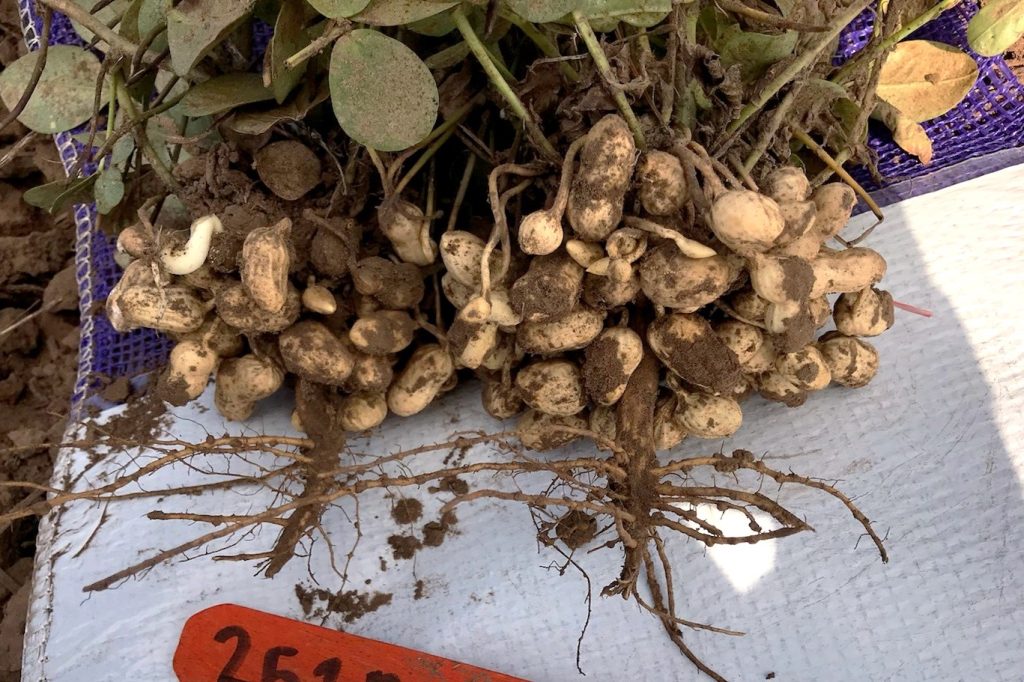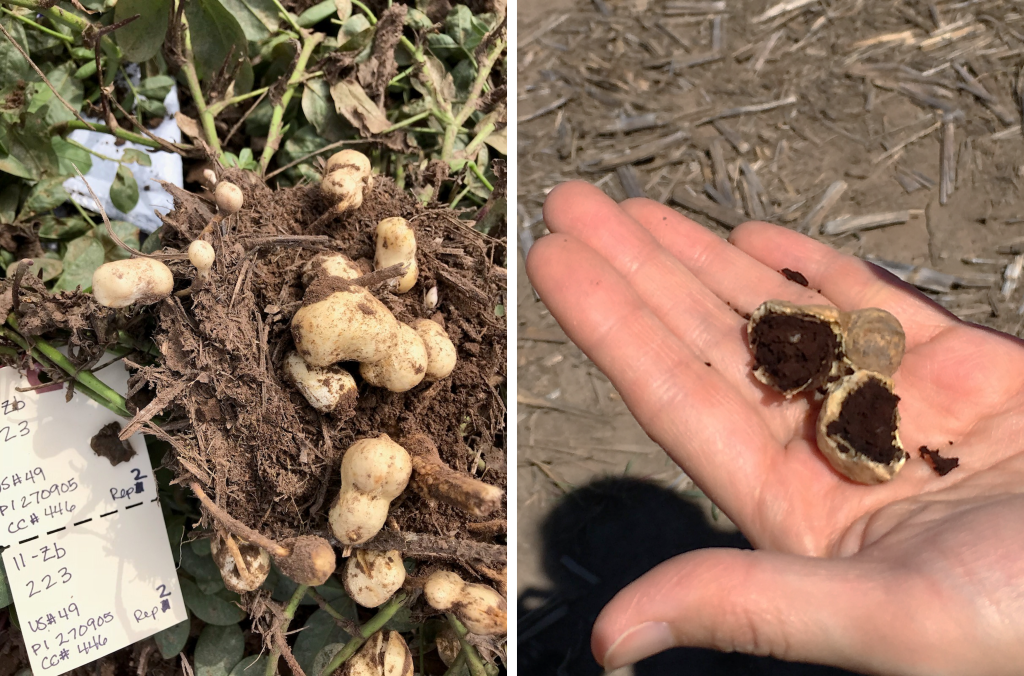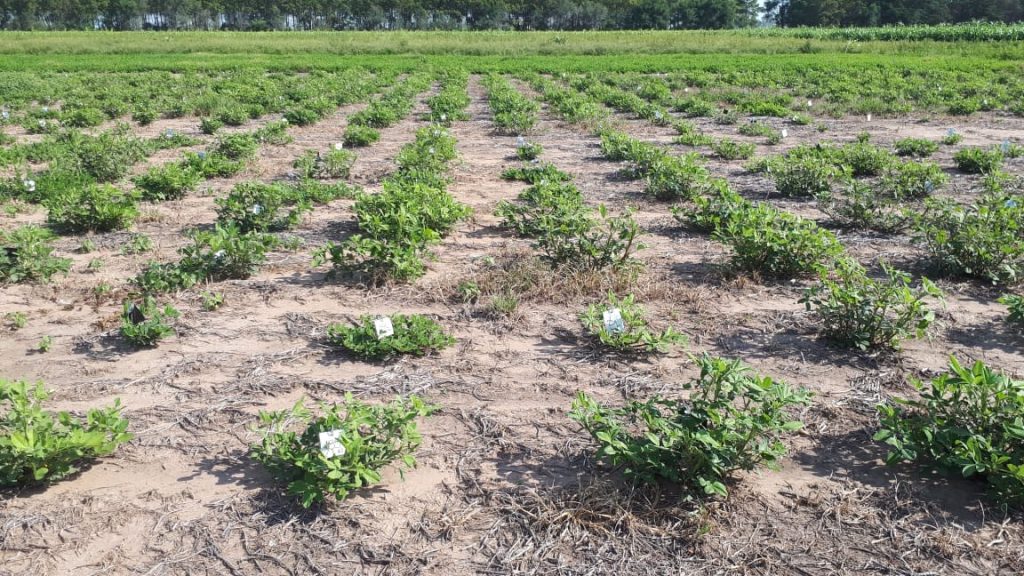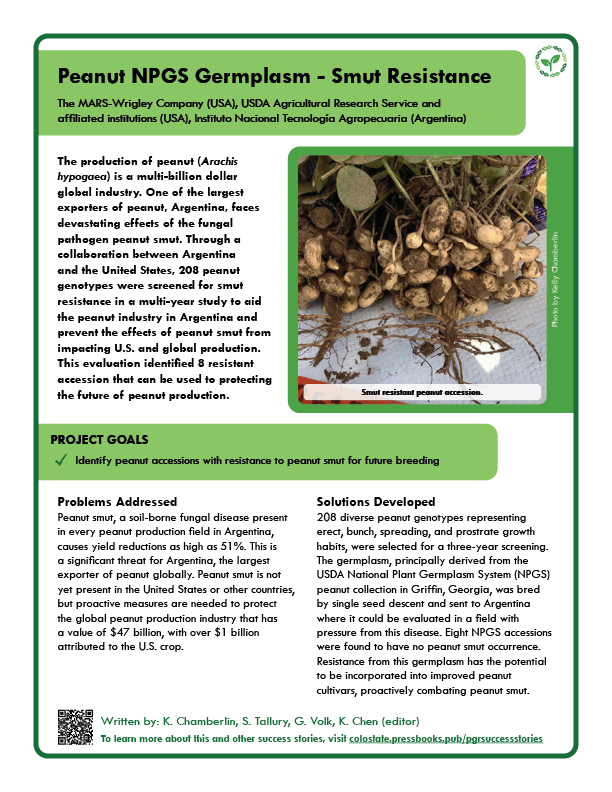Oilseeds
Peanut NPGS Germplasm – Smut Resistance
SCREENING PEANUT ACCESSIONS IN THE U.S. NATIONAL PLANT GERMPLASM SYSTEM FOR RESISTANCE TO PEANUT SMUT
Kelly Chamberlin; Shyam Tallury; and Gayle M. Volk
USDA-ARS Peanut and Small Grains Research Unit, 1301 N Western Rd, Stillwater, Oklahoma 74075.
USDA-ARS Plant Genetic Resources Conservation Unit, 1109 Experiment St, Griffin, Georgia 30223.
USDA-ARS National Laboratory for Genetic Resources Preservation, 1111 S Mason St, Fort Collins, Colorado 80521.
Corresponding authors: gayle.volk@usda.gov
OUTLINE
1. SUMMARY

The production of peanut (Arachis hypogaea L.) is a multi-billion dollar global industry. One of the largest exporters of peanut, Argentina, faces devastating effects of the fungal pathogen peanut smut (Thecaphora frezzii Carranza & Lindquist). Through a collaboration between Argentina and the United States, 208 peanut genotypes were screened for smut resistance in a multi-year study to aid the peanut industry in Argentina and prevent the effects of peanut smut from impacting U.S. and global production. Eight accessions had a 0% disease incidence over three years of disease exposure. This evaluation has successfully identified resistant germplasm for protecting the future of peanut production in the United States, Argentina, and across the world.
The goal was to identify peanut accessions in the U.S. National Plant Germplasm System collection with resistance to peanut smut for future use in breeding programs.
Download a printable fact sheet by clicking the image below.
2. PROBLEMS ADDRESSED

Peanut smut, a soil-borne fungal disease present in 100% of the peanut production fields in Argentina, causes yield reductions as high as 51%. It is not yet present in the United States or in other international locations, but proactive measures are needed to protect the global peanut production industry that has a value of $47 billion (data from 2020) with over $1 billion attributed to the U.S. crop. Argentina exports $800 million in peanut value, making it the largest exporter globally (Bressano et al., 2018).
3. SOLUTIONS DEVELOPED

Mars, Incorporated and the USDA Agricultural Research Service funded a three year (2017–2020) peanut smut screening evaluation. 208 genotypes representing accessions from the USDA National Plant Germplasm System (NPGS) peanut germplasm collection maintained by the Griffin, Georgia genebank unit, U.S. peanut breeding lines, and released cultivars were bred by single seed descent and then sent to Argentina for evaluation (Chamberlin et al., 2022; 2023). They represent erect, bunch, spreading, and prostrate growth habits. This evaluation identified several accessions with low peanut smut occurrence, including eight NPGS accessions with no occurrence (Chamberlin et al., 2022). This germplasm has the potential to be incorporated into breeding programs to proactively introgress peanut smut resistance into peanut cultivars.
Collaborators involved in developing solution:
- USDA-ARS Peanut and Small Grains Research Unit, Stillwater, Oklahoma, USA
- USDA-ARS Crop Genetics and Breeding Research, Tifton, Georgia, USA
- USDA-ARS Plant Genetic Resources Conservation Unit, Griffin, Georgia, USA
- HudsonAlpha Institute for Biotechnology, Huntsville, Alabama, USA
- University of Georgia Institute of Plant Breeding, Genetics, and Genomics, Tifton, Georgia, USA
- Rocky Vista University Biomedical Sciences Department, Parker, Colorado, USA
- Instituto Nacional Tecnología Agropecuaria (INTA) Estación Experimental Agropecuaria Manfredi, Manfredi, Argentina
- INTA Estación Experimental Agropecuaria Marcos Juárez, Marcos Juarez, Argentina
4. GERMPLASM

The single-seed descent material found to have peanut smut resistance originated from accessions maintained in the U.S. peanut germplasm collection by the Plant Genetic Resources Conservation Unit in Griffin, Georgia. The parent lines represent diverse origins: Uruguay (PI 162655 ); Brazil (PI 337293); Zambia (PI 268806, PI 270786, PI 271019); Mozambique (PI 481795); Japan (PI 200441); and Ecuador (PI 688294) (Chamberlin et al., 2022).
5. REFERENCES
Bressano M, Massa AN, Arias RS, de Blas F, Oddino C, Faustinelli PC, et al. 2019. Introgression of peanut smut resistance from landraces to elite peanut cultivars (Arachis hypogaea L.). PLoS ONE 14:e0211920. https://doi.org/10.1371/journal.pone.0211920
Chamberlin K, Baldessari J, Bennett R, Clevenger J, Holbrook C, Tallury S, Chu Y, Ozias-Akins P, Conde M, Payton M. 2022. Identification of Germplasm Resistant to Peanut Smut. Peanut Science 49:1-16. https://doi.org/10.3146/0095-3679-491-PS21-10
Chamberlin KD, Bennett RS, Baldessari J, De La Barrera G, Cordes G, Grandon NG, Mamani EMC, Rodriguez AV, Morichetti S, Holbrook CC, Ozias-Akins P, Chu Y, Tallury SP, Clevenger J, Korani W, Scheffler B, Youngblood R, Simpson S. 2023. Discovery of a resistance gene cluster associated with smut resistance in peanut. Peanut Science (in press).
6. CHAPTER INFORMATION
Citation: Chamberlin K, Tallury S., Volk GM. 2024. Peanut NPGS Germplasm – Smut Resistance. In: Volk GM, Chen K, Byrne P (Eds.) Plant Genetic Resources: Success Stories. Fort Collins, Colorado: Colorado State University. Date accessed. Available from https://colostate.pressbooks.pub/pgrsuccessstories/chapter/peanut-npgs-germplasm-smut-resistance/
Content originally submitted: January 13, 2024
Date of publication: May 20, 2024
USDA is an equal opportunity provider, employer, and lender. Mention of trade names or commercial products in this article is solely for the purpose of providing specific information and does not imply recommendation or endorsement by the U.S. Department of Agriculture.


